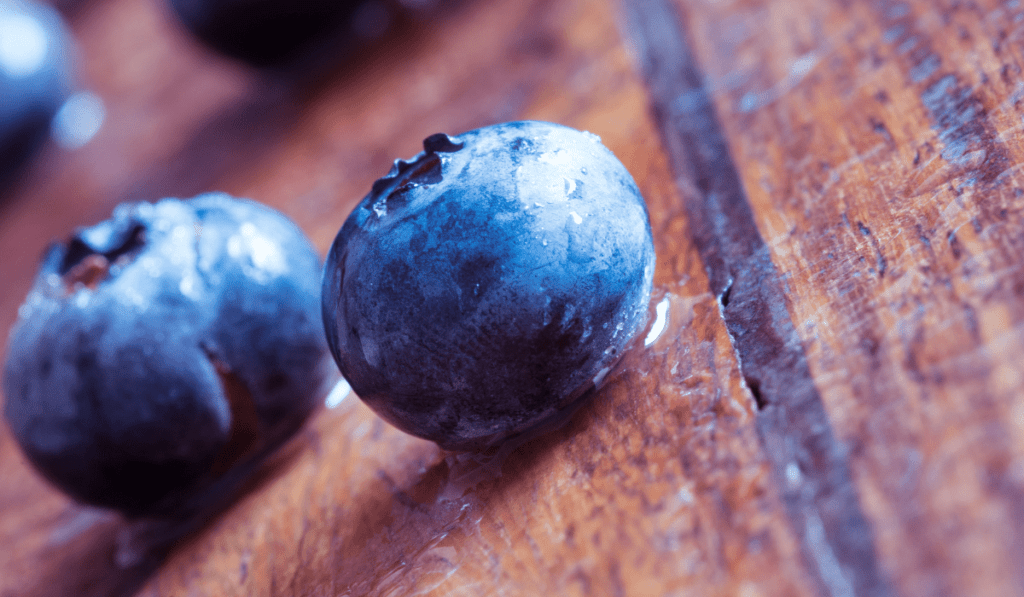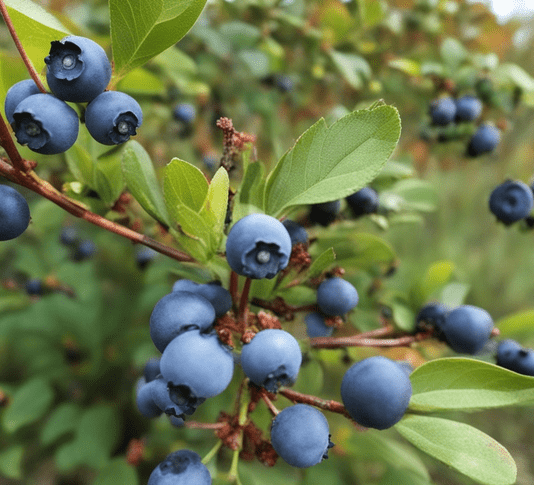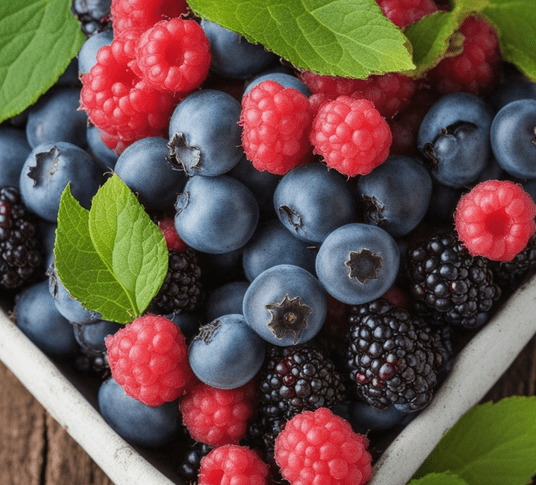Blueberry trees, cherished for their delectable fruits, are not immune to the challenges posed by various diseases. In this in-depth exploration, we will delve into the characteristics, symptoms, and preventive measures for the ten most common diseases affecting blueberry trees.
Disease #1: Leaf Spot (Cercospora)
Description: Leaf Spot, caused by the Cercospora fungus, manifests as dark spots on blueberry leaves. This disease is prevalent in humid conditions, particularly during periods of frequent rain.
Symptoms and Effects: Early signs include the appearance of small, dark lesions on leaves. As the disease progresses, these spots can coalesce, leading to premature leaf drop. Severe infections can compromise fruit production and overall plant vigor.
Prevention and Control Measures:
- Pruning: Remove infected leaves to reduce the spread of the fungus.
- Fungicides: Apply appropriate fungicides during the growing season to protect against leaf spot.
- Air Circulation: Ensure proper spacing between plants to enhance air circulation and reduce humidity.
Disease #2: Anthracnose
Description: Anthracnose is a fungal disease caused by several species of the Colletotrichum fungus. It affects various parts of the blueberry plant, including leaves, stems, and fruit.
Symptoms and Effects: Anthracnose is characterized by dark lesions on leaves and stems, which can lead to defoliation. In severe cases, the disease can affect developing fruit, causing premature drop and reducing overall yield.
Prevention and Control Measures:
- Pruning: Regularly prune and remove infected plant parts.
- Fungicides: Apply fungicides during the growing season to prevent and manage anthracnose.
- Proper Irrigation: Avoid overhead irrigation to minimize moisture on leaves.
Disease #3: Root Rot (Phytophthora)
Description: Root Rot, caused by the Phytophthora fungus, affects the roots of blueberry plants. It thrives in waterlogged or poorly-drained soils.
Symptoms and Effects: Wilting, yellowing of leaves, and overall decline in plant health are indicative of root rot. The disease interferes with the plant’s ability to absorb water and nutrients, leading to stunted growth.
Prevention and Control Measures:
- Improved Drainage: Ensure well-drained soil to prevent waterlogging.
- Fungicides: Application of appropriate fungicides can help manage Phytophthora.
- Avoid Overwatering: Maintain proper irrigation practices to prevent excess soil moisture.
Disease #4: Powdery Mildew
Description: Powdery Mildew is a common fungal disease caused by different species of fungi belonging to the Erysiphales order. It thrives in warm, dry conditions.
Symptoms and Effects: Characteristic white, powdery spots appear on leaves, impacting photosynthesis. Severe infections can lead to distorted growth and reduced fruit quality.
Prevention and Control Measures:
- Fungicides: Regular applications of fungicides can help prevent and manage powdery mildew.
- Proper Spacing: Ensure adequate spacing between plants to improve air circulation.
- Pruning: Remove infected plant parts to reduce the spread of the fungus.
Disease #5: Botrytis Fruit Rot (Gray Mold)
Description: Botrytis Fruit Rot, caused by the Botrytis cinerea fungus, affects blueberry fruit, particularly in humid conditions.
Symptoms and Effects: Infected berries develop mold, appearing gray or brown. The fruit becomes soft and shriveled, leading to reduced quality and market value.
Prevention and Control Measures:
- Pruning: Proper pruning promotes air circulation, reducing humidity around the fruit.
- Fungicides: Apply fungicides during flowering to protect against Botrytis.
- Harvest Timing: Harvest fruit promptly to prevent overripening and susceptibility to the fungus.
Disease #6: Blueberry Scorch Virus
Description: Blueberry Scorch Virus is a viral disease transmitted by aphids and other insect vectors. It primarily affects highbush blueberry varieties.
Symptoms and Effects: Infected plants exhibit symptoms such as leaf scorching, yellowing, and overall decline. Fruit production is significantly reduced, impacting yield.
Prevention and Control Measures:
- Vector Control: Manage aphid populations through insecticide applications.
- Culling Infected Plants: Remove and destroy infected plants to prevent the spread of the virus.
- Resistant Varieties: Consider planting blueberry varieties resistant to Blueberry Scorch Virus.
Disease #7: Phomopsis Twig Blight
Description: Phomopsis Twig Blight, caused by the Phomopsis vaccinii fungus, affects blueberry stems and shoots.
Symptoms and Effects: Visual indicators include wilting and dieback of shoots, with lesions appearing on stems. Severe infections can lead to reduced fruiting and overall plant vigor.
Prevention and Control Measures:
- Pruning: Regularly prune and remove infected shoots.
- Fungicides: Application of appropriate fungicides during the growing season.
- Proper Watering: Avoid overhead irrigation to minimize moisture on stems.
Disease #8: Rust Diseases
Description: Rust Diseases, caused by various fungi in the Puccinia genus, manifest as orange, powdery spots on leaves.
Symptoms and Effects: Affected leaves develop rust-colored spots, leading to premature leaf drop. Severe infections can weaken the plant and impact fruit quality.
Prevention and Control Measures:
- Fungicides: Regularly apply fungicides to prevent and manage rust diseases.
- Pruning: Remove infected leaves to reduce the spread of spores.
- Proper Ventilation: Ensure proper air circulation to minimize humidity.
Disease #9: Armillaria Root Rot
Description: Armillaria Root Rot, caused by the Armillaria mellea fungus, affects the roots of blueberry plants.
Symptoms and Effects: Distinctive signs include wilting, decline, and death of the plant. The disease is persistent, with soil-borne pathogens contributing to its spread.
Prevention and Control Measures:
- Soil Management: Improve soil drainage and health to discourage the spread of the fungus.
- Pruning: Remove and destroy infected plants promptly.
- Resistant Varieties: Consider planting blueberry varieties resistant to Armillaria Root Rot.
Disease #10: Verticillium Wilt
Description: Verticillium Wilt is a soil-borne fungal disease caused by Verticillium spp. It affects the vascular system of blueberry plants.
Symptoms and Effects: Distinctive signs include wilting, yellowing, and eventual death of branches. The disease can impact overall plant health and fruit production.
Prevention and Control Measures:
- Soil Sterilization: Practice soil sterilization to reduce the presence of the pathogen.
- Resistant Varieties: Choose blueberry varieties resistant to Verticillium Wilt.
- Proper Irrigation: Maintain consistent soil moisture levels to reduce stress on the plant.
Strategies for Disease Prevention and Management in Blueberry Orchards
Ensuring the health and vitality of blueberry orchards requires a comprehensive approach to disease prevention and management. By implementing proactive practices and prioritizing soil health, growers can mitigate the risk of common diseases. Let’s delve into strategic measures that form the foundation of a resilient and disease-resistant blueberry orchard.
Proactive Orchard Practices
Optimal Spacing for Air Circulation
Creating ample space between blueberry plants is a fundamental strategy for disease prevention. Adequate spacing enhances air circulation, reducing humidity levels around the plants. This, in turn, minimizes the favorable conditions for fungal diseases such as powdery mildew and leaf spot. Proper air circulation is crucial for maintaining dry foliage and preventing the onset and spread of diseases.
Mulching Techniques
Proper mulching is a valuable practice in orchard management. Mulch serves as a protective layer around the base of blueberry plants, offering several benefits. It regulates soil moisture by preventing excessive evaporation, ensuring consistent hydration for the plants. Additionally, mulch helps control soil temperature, creating a favorable environment for root health. By maintaining optimal soil conditions, mulching contributes to overall plant vigor, making blueberry bushes more resilient to diseases.
Soil Health and Disease Resistance
Role of Soil Amendments
Incorporating organic matter and beneficial microorganisms into the soil is a proactive measure with profound implications for disease resistance. Healthy soil teeming with beneficial microbes creates a robust ecosystem that suppresses harmful pathogens. Organic matter acts as a nutrient source, supporting the growth of beneficial microorganisms while enhancing the overall structure of the soil. This, in turn, fortifies the plants against diseases and promotes a thriving blueberry orchard.
Soil pH Adjustment
Soil pH plays a pivotal role in the development and prevalence of certain diseases. Adjusting the soil pH to the optimal range creates conditions less favorable for pathogens. Regular soil testing is essential to monitor pH levels, and adjustments can be made by incorporating amendments such as lime. By maintaining the right pH, growers create an environment that is less conducive to diseases like root rot and ensures the overall well-being of blueberry plants.
Disease-Resistant Blueberry Varieties
Identifying Resistant Varieties
Choosing blueberry varieties with natural resistance to common diseases is a strategic and proactive approach. Nurseries and breeders often provide information about the disease resistance profiles of different cultivars. By selecting varieties known for their resilience, growers can significantly reduce the risk of disease outbreaks in their orchards. This approach aligns with the principle of prevention being more effective than cure.
Diversifying Plantings
Cultivating a Diverse Range of Blueberry Varieties
Monoculture, or the cultivation of a single variety, can make orchards more vulnerable to diseases. Diversifying plantings by incorporating various blueberry varieties contributes to enhanced resilience. Different varieties may have varying levels of susceptibility to specific diseases. By diversifying, growers create a more dynamic and robust orchard ecosystem, reducing the risk of diseases spreading rapidly through the entire plantation.
Conclusion:
In conclusion, a proactive approach to disease management is paramount for cultivating healthy and productive blueberry trees. By understanding the characteristics, symptoms, and preventive measures for common diseases, blueberry growers can implement effective strategies to protect their crops. Regular monitoring, proper sanitation, and timely interventions contribute to the overall well-being of blueberry trees, ensuring a bountiful harvest and the longevity of this beloved fruit-bearing plant.



